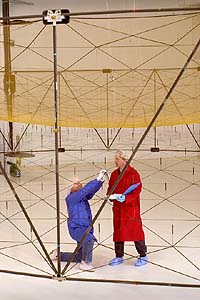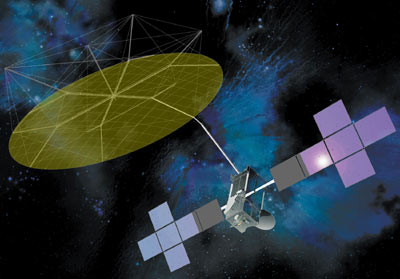Satellite Phones Getting WiMAXed
Posted by Sam Churchill on December 19th, 2008TerreStar Europe, a European mobile communications company and a subsidiary of TerreStar Corporation, announced that its application with the European Commission (EC) for a Pan-European 2GHz MSS S-band spectrum authorisation has been accepted.
TerreStar Europe plans to create a pan-European integrated satellite and complementary ground component network that is designed to provide wholesale mobile voice, data and video services across both a satellite and terrestrial based mobile broadband network. It will be available to government, emergency responders, enterprises and consumers for ubiquitous connectivity across urban, rural and remote regions of Europe.
TerreStar is a giant geosynchrous satellite phone system designed to provide next-generation, 2-GHz mobile voice and data communications, monitoring and messaging services throughout the United States and Canada. The TerreStar broadband network can use both traditional land-based wireless networks and the satellite network. The terrestrial repeaters use the same frequency as the satellite, enabling small, inexpensive mobile phones with a direct to satellite capability.
Last month the FCC granted an extension of its U.S. satellite launch milestone from September 30, 2008 to June 30, 2009. TerreStar requested the extension because of issues experienced during construction of its satellite reflector. In September 2008, Industry Canada (IC), the federal government department in Canada which is responsible for radio spectrum licensing and telecommunications policy, granted a similar request by TerreStar Networks.
“TerreStar greatly appreciates the grant of the extension requests by both the FCC and IC,” said Jeffrey Epstein, President of TerreStar Networks Inc. “We will continue to maintain momentum and focus on realizing our vision of North America’s first IP-enabled integrated satellite-terrestrial mobile broadband network.”
Progress on the construction of the TerreStar-1 satellite (TS-1) has reached a very advanced stage at Space Systems/Loral in Palo Alto, California.
The S-Band feed array has recently completed final testing and is being integrated onto the satellite. The S-Band reflector, being constructed by Harris Corporation in Palm Bay, Florida, recently completed its first hands-free deployment. Likewise, ground support systems are also progressing, including acceptance of the North Las Vegas, Nevada feeder link facilities and construction of the Telemetry Monitoring, Tracking, and Control facilities in Allan Park, Ontario.
TerreStar plans to launch its TerreStar-1 satellite in the second quarter of next year. Earlier the company had planned on a Dec. 2008 to Feb. 2009 launch. TerreStar-2, scheduled for delivery in 2009, features a large unfurlable reflector similar to TerreStar-1. The satellite will generate hundreds of spot beams covering the Continental U.S., Canada, Alaska, Hawaii, Puerto Rico and the U.S. Virgin Islands.
 Meanwhile, ICO Global Communications today announced changes to the boards of directors for both ICO Global and its subsidiary, ICO North America.
Meanwhile, ICO Global Communications today announced changes to the boards of directors for both ICO Global and its subsidiary, ICO North America.
Nicolas Kauser has joined the board of ICO Global Communications. Mr. Kauser is a principal of Eagle River Holdings, LLC and he serves on the boards of RadioFrame Networks and Triquint Semiconductor. He has previously held the position of chief technology officer at both AT&T Wireless Services and Clearwire Corporation, and served as president of Clearwire International.
ICO Global directors R. Gerard Salemme, Donna Alderman and Benjamin Wolff have resigned from the board of ICO Global, and will remain on the board of ICO North America. Craig McCaw has resigned from the board of ICO North America, and will remain on the board of ICO Global. All other directors for ICO Global and ICO North America will continue to serve in their respective existing capacities.
ICO is the elephant in the room for Clearwire. It will deliver mobile television via DVB-SH.
ICO G1 was successfully launched on April 14, 2008. G1 is now on station at 92.85 degrees West Longitude in geosynchronous orbit.
 In September, ICO announced that WiMAX provider Clearwire will join as a service partner for its alpha trial in Raleigh Durham, North Carolina, and that an additional trial will take place in Las Vegas, NV. ICO will use DVB-SH for mobile video, delivering 10-15 channels of premium live TV content for 7–15 inch screens. Harris also built the reflector for TerreStar Networks’s geostationary TerreStar-1 mobile communications satellite; and two reflectors for XM Satellite Radio’s XM-5 radio broadcast satellite.
In September, ICO announced that WiMAX provider Clearwire will join as a service partner for its alpha trial in Raleigh Durham, North Carolina, and that an additional trial will take place in Las Vegas, NV. ICO will use DVB-SH for mobile video, delivering 10-15 channels of premium live TV content for 7–15 inch screens. Harris also built the reflector for TerreStar Networks’s geostationary TerreStar-1 mobile communications satellite; and two reflectors for XM Satellite Radio’s XM-5 radio broadcast satellite.
Both ICO and TerreStar have 20 MHz each in the MSS band (2.0/2.1 GHz). They’ll deliver spotbeam satphone services from geosynchronous space, supplemented with terrestrial repeaters.
Meanwhile, Globalstar, which operates a LEO-based satellite phone system (similar to Iridium), is also talking about sharing terrestrial frequencies and towers.
Globalstar has won approval from the FCC to incorporate WiMAX in the ATC with the help of terrestrial partner Open Range Communication. The two will offer WiMAX to more than 500 rural communities–with the help of a $267 million loan from the Department of Agriculture’s Rural Development Utilities Program. Globalstar said it will be looking for other partners too.
But satellite mobile television service failed in Japan, even though the country has a concentrated population footprint with gadget-loving citizens.
Toshiba is shutting down its four-year-old, satellite-based digital multimedia broadcasting service in Japan, which it offers through their Mobile Broadcasting Corporation unit.
The MBSAT from Mobile Broadcasting Corporation is a three-axis attitude stabilized geostationary satellite designed and manufactured by Space Systems / Loral, based on the SS/L 1300 bus and featured a 12m-aperture (40 foot) S band high gain antenna.

Toshiba said the Japanese service has failed to attract sufficient customers in the face of demand for free mobile broadcasting services that are targeting mobile handsets. Toshiba said it will dissolve the company and end services by March of next year. It is expected to cost Toshiba about $232 million. The company launched the service in Oct. 2004.
source : dailywireless.org







No comments:
Post a Comment